An online project under the direction of the CAPE ANN MUSEUM
inv. 259
Cunard Liner "Britannia"
"Brittannia"; Ship in a gale, Brittania; Steamer Britannia in a Gale
1842 Oil on canvas 30 1/4 x 42 in. (76.8 x 106.7 cm) Signed and dated lower right: F.H. Lane 1842
|
Related Work in the Catalog
Explore catalog entries by keywords view all keywords »
Historical Materials
Below is historical information related to the Lane work above. To see complete information on a subject on the Historical Materials page, click on the subject name (in bold and underlined).
Newspaper
p. 2 col. 2
"There is a beautiful painting exhibiting at the window of W. H. Oakes's music store, No. 13 Tremont Row. It represents the steamship Britannia during the most terrific gale she ever encountered. It was on the morning of the 23d of April last, on her passage from Liverpool to this port. The picture was painted expressly for Capt. Cleland, by Mr F.H. Lane, one of the best painters of sea views in the country."
Oil on canvas
24 x 35 in.
Peabody Essex Museum, Salem, Mass.
Walters' painting depicts the "Nonantum" homeward bound for Boston from Liverpool in 1842. The paddle-steamer is one of the four Clyde-built Britannia-class vessels, of which one is visible crossing in the opposite direction.
Samuel Cunard founded the Cunard Line in 1840. Four new liners were commissioned, to be launched on February 5. The first of the new class was called "Britannia"; three sisters of "Britannia" were "Acadia," "Caledonia," and "Columbia." The "Britannia" was a side-wheel steamship with a barkentine rig (square-rigged on the foremast; fore-and-aft rigged on the main and mizzen masts). She also had an orange-red straight funnel, and luxurious interiors.The sails were for steadying her motion in heavy seas, maintaining headway, and staying on course if the engines broke down.
The liner operated on a regular schedule. She was built on the Clyde in Glasgow and arrived in Liverpool in June 1840. She departed on July 4 and arrived in Boston July 17. She was berthed at the specifically designed "Cunard Wharf" to great excitement in Boston. Charles Dickens, his wife Kate, and their maid were passengers for the crossing in January 1842. In January 1844, Boston Harbour froze and trapped the ship as she was about to leave for Liverpool. A seven-mile channel was created to free her so that she could keep to her schedule. Her final crossing was in 1848, when she was sold to the German navy.
"Britannia" statistics: 207 feet long; 1,139 tons; 9 knot service speed; 115 passengers.
Royal Museums, Greenwich
Speech presenting the silver wine service to Captain John Hewitt by the passengers after the safe arrival of the steamship "Britannia" in Boston.
overall: 190 x 110 mm
National Maritime Museum, Greenwich
PLT 0200, 0201, 0202, 0203
One of a pair of American silver goblets presented to Captain John C. Hewitt by the passengers of the "Britannia" steamship.
A four-piece wine set with its original wooden carrying case presented to Captain John C. Hewitt by the passengers of the 'Britannia' steamship, 1842. The goblet is on a foliate-chased rising circular base, with a balaster stem and moulded rim, the bowl chased with rising acanthus leaves. It is inscribed: "Presented to Capt. John Hewett [sic] of the Britannia Steamship by the passengers, January 1842"; the base has a wooden inset covered in red baize. The wine set was presented to Captain Hewitt on January 29, 1842 in the Tremont Theatre, Boston. Charles Dickens wrote an account of his stormy transatlantic crossing on board the "Britannia" in the second chapter of American Notes (1842).
17 1/4 x 24 7/8 in.
American Antiquarian Society, Worcester, Mass.
Also filed under: Boston Harbor » // Bouvé & Sharp, Lith. – Boston » // De Vaudricourt, Augustus » // Sharp's, J. C., Lith. – Boston »
5.6.1841
Newspaper
p. 2 col. 1
"Arrival of the Britannia.
12 days later from England.
Highly Important from China: Great Fall in the Price of Teas: Great Excitement in Relation to the Non-Arrival of the Steamer President.
The Royal Mail steamship Britannia, Capt R. B. Cleland, arrived at this port this morning, at 2' clock, from Liverpool, having left on the 20th ult. at 12 M. She ran 200 miles to the south of her course, to avoid the ice, which lengthened her passage. Arrived at Halifax on Tuesday morning, and left at 1 P.M., making her passage to Boston in 38 hours. She had 87 passengers to Halifax, landed 56, and took in 9 additional for Boston."
Also filed under: Cleland, Captain Richard » // Newspaper / Journal Articles »
Newspaper
p.3
"...On the 25th, 26th, and 27th, the Britannia experienced very severe gales, and on Sunday the 26th she shipped a sea which stove the bulwarks on the larboard bow, and broke the leg of one of the crew..."
Also filed under: Newspaper / Journal Articles »
Newspaper
col.1
"The Britannia arrived out on the 29th... the fastest passage ever made..."
Also filed under: Newspaper / Journal Articles »
Newspaper
p. 2 col. 2
"There is a beautiful painting exhibiting at the window of W. H. Oakes's music store, No. 13 Tremont Row. It represents the steamship Britannia during the most terrific gale she ever encountered. It was on the morning of the 23d of April last, on her passage from Liverpool to this port. The picture was painted expressly for Capt. Cleland, by Mr F.H. Lane, one of the best painters of sea views in the country."
"Vesting and Pantaloon Stuffs Per Steamer Britannia"
Also filed under: Newspaper / Journal Articles »
"It is the third morning. I am awakened out of my sleep by a dismal shriek from my wife who demands to know whether there's any danger. I rouse myself and look out of bed. The water jug is plunging and leaping like a lively dolphin; all the smaller articles are afloat except my shoes which are stranded on a carpet bag high and dry, like a couple of coal barges. Suddenly I behold them spring into the air and see the looking glass, which is nailed to the wall, sticking fast upon the ceiling. At the same time the door entirely disappears and a new one is opened in the floor. Then I begin to comprehend that the state room is standing on its head.
Before it is possible to make any arrangement at all compatible with this novel state of things, the ship rights. Before one can say: 'Thank Heaven!' she wrongs again. Before one can cry: 'She is wrong' she seems to have started forward and to be a creature actively running of its own accord, with broken knees and failing legs, through every variety of hole and pitfall, and stumbling constantly. Before one can so much as wonder, she takes a high leap into the air. Before she has well done that, she takes a deep dive into the water. Before she has gained the surface, she throws a somerset. The instant she is on her legs, she rushes backward. And so she goes on, staggering, heaving, wrestling, leaping, diving, jumping, pitching, throbbing, rolling and rocking, and going through all these movements sometimes by turns and sometimes all together until one feels disposed to roar for mercy."
Also filed under: Chronology » // Letters »
lithograph
15 x 25 in (38.1 x 63.5 cm)
Peabody Essex Museum
Also filed under: Bouvé & Sharp, Lith. – Boston »
Pottery
9 in (22.86 cm)
M3233
Peabody Essex Museum
This China was issued to celebrate the establishment of the British and North American Royal Mail Steam Packet Company, which later became Cunard. Some might have been used on board Britannia and the other three ships depicted.
Ship model
50'/1"
M15732
Peabody Essex Museum
Also filed under: Objects »
Library of Congress Catalog Number 2004671768
Also filed under: Boston Harbor »
In the ninteenth century, the term "bark" was applied to a large sailing vessel having three masts, the first two (fore and main) being square-rigged; the third (mizzen), fore-and-aft rigged. The reduced square-rig made the vessel easier and more economical to handle, using a smaller crew. (1)
Barks had significant presence in mid-nineteenth-century America, as indicated by Lane’s depictions of them. Hardly any are to be found in his scenes of major ports, but some do appear in his Cape Ann scenes (see The Fort and Ten Pound Island, Gloucester (Harbor Scene), 1848 (inv. 58), View of Gloucester, 1859 (inv. 91), Gloucester Harbor, 1850s (inv. 391), and Bark "Eastern Star" of Boston, 1853 (inv. 571)), also in views of other small ports and of coastal shipping (see Clipper Ship "Southern Cross" in Boston Harbor, 1851 (inv. 253), Merchantmen Off Boston Harbor, 1853 (inv. 267), Approaching Storm, Owl's Head, 1860 (inv. 399), and Bark "Mary" (inv. 629)).
Brigs, and to a lesser extent ships, were the vessels of choice for Gloucester’s foreign trade in the first half of the nineteenth century. They brought cargos from the West Indies, South America, and Europe, anchoring in the deeper parts of the Inner Harbor while lighters off-loaded the goods and landed them at the wharves in Harbor Cove, by then too shallow for the newer, larger merchant vessels coming into use. (2) By mid-century, barks were gradually replacing brigs and ships, while the trade with Surinam was removed to Boston in 1860. (3)
Some bulk cargos still had to be landed in Gloucester, salt for curing fish being the most important. “Salt barks” brought Tortugas salt from the West Indies, and in the 1870s, Italian salt barks began bringing Trapani salt from Sicily. The importation of salt by sailing ships ended with the outbreak of World War I. (4)
The term barkentine, like the bark, pre-dates the nineteenth century, but in the mid- to late 1800s referred to a large vessel of three masts (or more), with only the fore mast square-rigged, the others being fore-and-aft-rigged. In Lane’s time, the term was little known in the United States, while many other names were coined for the rig. One of these early terms was demi-bark, probably from the French demi-barque, which was applied to a very different kind of vessel. (5) Lane’s depictions of these rigs include a lithograph of the steam demi-bark "Antelope" View of Newburyport, (From Salisbury), 1845 (inv. 499) and at least three depictions of Cunard steamships The "Britannia" Entering Boston Harbor, 1848 (inv. 49), Cunard Steamship Entering Boston Harbor (inv. 197), and Cunard Liner "Britannia", 1842 (inv. 259). (6) None of these subjects typify the barkentine rig as applied to sails-only rigs as they developed in the years after Lane’s death.
– Erik Ronnberg (May, 2015)
References:
1. R[ichard] H[enry] Dana, Jr., The Seaman's Friend (Boston; Thomas Groom & Co., 1841. 13th ed., 1873), 97 and Plate IV with captions; and M.H. Parry, et al., Aak to Zumbra: A Dictionary of the World's Watercraft (Newport News, VA: The Mariners’ Museum, 2000), 43.
2. Alfred Mansfield Brooks, Gloucester Recollected (Gloucester, MA: Peter Smith, 1974), 56, note 10; 67, note 7.
3. James R. Pringle, History of the Town and City of Gloucester (1892. Reprint: Gloucester, MA, 1997), 106–08.
4. Raymond McFarland, A History of the New England Fisheries (Philadelphia: University of Pennsylvania, 1911), 95–96; and Mark Kurlansky, Salt: A World History (New York: Walker & Co., 2002), 419–420.
5. Parry, 44, 167. Dana has neither definition nor illustration of this rig.
6. J[ohn] W. Griffiths, “The Japan and China Propeller Antelope," U.S. Nautical Magazine III (October 1855): 11–17. This article includes an impression of Lane’s lithograph on folded tissue.
Stereograph card
Cape Ann Museum Library & Archive
This view of Gloucester's Inner Harbor shows three square-rigged vessels in the salt trade at anchor. The one at left is a (full-rigged) ship; the other two are barks. By the nature of their cargos, they were known as "salt ships" and "salt barks" respectively. Due to their draft (too deep to unload at wharfside) they were partially unloaded at anchor by "lighters" before being brought to the wharves for final unloading.
– Erik Ronnberg
Also filed under: Historic Photographs » // Salt » // Waterfront, Gloucester »
"Engine-powered vessel" is a collective term used by nautical historians to include all vessel types using engine power of any type for propulsion, whether assisted by sails, oars, or other motive power. In Lane's time, steam reciprocating engines fueled by wood or coal were the only practical source of this power for ships using paddle-wheels or screw propellers to convert heat energy into motion.
For most of the nineteenth century, steamships had sails for auxiliary power; indeed the earliest examples relied principally on sails, using engine power in calm weather to shorten the voyage time or keep to a schedule. As engines became more efficient, powerful, and reliable, sail plans were reduced, to be used only to steady a vessel's motion in a seaway (for the sake of seasick passengers), or to maintain headway if the engine broke down. Only harbor craft, ferry boats, and coastwise passenger steamers relied solely on engine power.
Among Lane's depictions of steamships, the auxiliary steam packet Auxiliary Steam Packet Ship Massachusetts (inv. 442) is a good example of primary reliance on sails, while the steam demi-bark The "Britannia" Entering Boston Harbor, 1848 (inv. 49) and the Cunard Liner "Britannia", 1842 (inv. 259) have relegated sails to secondary (or simply emergency) motive power.
– Erik Ronnberg
Castine Historical Society Collections (2015.03)
Also filed under: Historic Photographs » // Steamers »
Published by James French, Boston
Volume 1848-49
Boston Public Library
Call number 39999059856813
See p. 30 of directory.
Also filed under: "Britannia" (Cunard Steamship) » // "Caledonia" (Cunard Steamship) » // Trade Routes and Statistics »
Cartoon
9 1/4 x 13 3/4 in (23.495 x 34.925 cm)
Peabody Essex Museum, Salem, Mass.
Jonny and a Yankee:
Jonny: "Ho my Hi! 'ow she goes!! it his'nt fair I ham sure t'aint!!! She must 'av an engine hunder the keel..."
Yankee: "Where are your yachts now, Jonny? s-a-y- Do you think your wash tubs can come up to a real Yankee Clipper? Sorry for you, Jonny, but it can't be helped... A Yankee Ship a Yankee Crew, you know Jonny."
Also filed under: "America" (Schooner Yacht) »
Lithograph
Library of Congress Catalog Number 2002706878
Design of side wheel steamer showing wheel mechanism, side view and cross-section in ten figures. This design proved a failure in the few vessels that employed it. The paddle wheel enclosures filled with water, causing resistance which greatly impaired efficiency and increased fuel consumption.
– Erik Ronnberg
Oil on canvas
Maine Maritime Museum
Also filed under: Castine »
Steamer schedules for 1855, including the schedule for the steamer, "T. F. Secor" which served Castine, see pp. 234–35.
Also filed under: "T. F. Secor" (Steamboat) » // Castine » // Publications » // Steamers »
Vessel ornamentation assumed two forms: carvings and color schemes. Carvings, or "ship carvings," as they are called by maritime scholars, are usually crafted in wood and painted or gilt. Many vessels were too small or their owners too frugal to permit carved embellishments, in which cases the enhancement of the vessel's color scheme was a practical alternative. This can be seen in many of the coastal vessels along the new England coast. Pinkies and Chebacco boats had handsome color schemes using only black and green with white sheer lines and limited use of red and yellow. Other combinations of inexpensive pigments were used to improve the simple looks of sloops and schooners in the packet trade, while small pleasure craft and pilot schooners enhanced their appearance in similar ways. Clipper ship owners, finding their vessels' appearance impressive without adding color, settled for unrelieved black hulls. Naval vessels as well preserved their formidable looks with black, relieved only with a white belt in way of the gunports.
The more elaborate ship carvings can be classified in the following categories:
Billetheads: mounted on the bow, at the end of a simple gammon knee, or on the forward end of an elaborate stem-head, they can be scrolls of less or greater intricacy, or sometimes the heads of animals, eagles being the most common. Examples of a sea serpent's head, a pointing hand, and other animal heads have been found. (See Brig "Cadet" in Gloucester Harbor, late 1840s (inv. 13); Brig "Antelope" in Boston Harbor, 1863 (inv. 43); and Brig Off the Maine Coast, 1851 (inv. 241))
Figureheads: mounted on bows of larger vessels, often with elaborate stem joinerwork (trailboards and headboards with associated knees and rails). Usually these were full-length figures representing the ship's owner, a famous citizen, a mythological person or animal, or an eagle. (See Portrait of the "National Eagle", 1853 (inv. 35) (eagle); New York Harbor, c.1855 (inv. 46); The "Britannia" Entering Boston Harbor, 1848 (inv. 49) (female figures); The Ships "Winged Arrow" and "Southern Cross" in Boston Harbor, 1853 (inv. 54) (dragon and eagle); "Starlight" in Harbor, c.1855 (inv. 249) (dragon); and Steam demi bark Antelope, 615 tons, c.1855 (inv. 375) (antelope))
Trailboards: carved vines or scrollwork abaft the figurehead which trail aft along the stem head in a graceful descending arc, terminating at the hawse pipes. They are usually gilt and frequently ornamented with carved rosettes and other devices. (See Brig "Cadet" in Gloucester Harbor, late 1840s (inv. 13); Portrait of the "National Eagle", 1853 (inv. 35); Brig "Antelope" in Boston Harbor, 1863 (inv. 43); New York Harbor, c.1855 (inv. 46); and The Ships "Winged Arrow" and "Southern Cross" in Boston Harbor, 1853 (inv. 54))
Headboards: boards mounted to headrails connecting the figurehead to the ship's mainrail at the catheads. While seldom given any decorative carvings, the vessel's nameboards were often mounted to them. (See Brig "Cadet" in Gloucester Harbor, late 1840s (inv. 13); Portrait of the "National Eagle", 1853 (inv. 35); Brig "Antelope" in Boston Harbor, 1863 (inv. 43); The Ships "Winged Arrow" and "Southern Cross" in Boston Harbor, 1853 (inv. 54); Clipper Ship "Southern Cross" in Boston Harbor, 1851 (inv. 253); and Mary Ann, 1846 (inv. 309))
Catheads: Carved lion heads mounted on the outboard ends of the cathead knees. This term is so archaic that the knees and carvings are treated as one and the same, as in their use, i.e. "catting the anchor" (securing the anchor ring to the cathead). (See Brig "Antelope" in Boston Harbor, 1863 (inv. 43); and An American Frigate Hove-to Off the New England Coast (inv. 535))
Quarterboards: Name boards mounted to the vessel's side near the stern, they usually had ornamental edge moldings and sometimes stars or simple scrollwork at each end of the name. (See Portrait of the "National Eagle", 1853 (inv. 35); Mary Ann, 1846 (inv. 309); and Spitfire Entering Boston Harbor (inv. 536))
Transom arches: arch-form panels fitted to the transom, often over gallery lights (windows) or other carvings. They usually have edge moldings, decorative scrollwork, and sometimes a bust or other carved figure at the center.
Other transom carvings: carved eagles, busts, scrollwork and coats of arms can occupy the space between the transom arch and the sternboard. If galleries are present, carved scrollwork may be fitted between the frames of the gallery lights. (See Boston Harbor, c.1850 (inv. 48); The Topsail Schooner "Kamehameha III" in Boston Harbor, 1846 (inv. 301) (eagle); Baltimore Harbor, 1850 (inv. 400) (eagle); and Rough Sea, Schooners, c.1856 (not published) (eagle and flags))
Sternboard: often the bottom plank of the transom on which the vessel's name is carved or painted, seldom with decoration (stars or scrollwork). There is usually simple protective molding above and below the lettering.
Sideboards, or gangway boards: boards on either side of an entry way at main rail level on a large ship, usually between the main and mizen masts. They are carved and painted or (if of fine hardwood) varnished. Most commonly seen on larger vaval vessels, packet ships, and clipper ships.
– Erik Ronnberg
References:
1. Brewington, M. V., Shipcarvers of North America, (Barre, MA: Barre Publishing Co., 1962).
2. The American Neptune, Pictorial Supplement XIX, "The Art of the Shipcarver" (Salem, MA: The Peabody Museum, 1977).
3. Ship Figureheads (Boston: State Street Trust Co., n.d.).
4. Edouard A. Stackpole, Figureheads & Carvings at Mystic Seaport (Mystic, CT: The Marine Historical Association, Inc., 1964).
Carved wood with paint and gilt
12 x 22 x 8 in.
Cape Ann Museum. Gift of George W. Woodbury, 1936 (747)
This sea serpent billet head came from the schooner "Diadem" which was built in Essex, Massachusetts, in 1855 and owned by D. Elwell Woodbury and John H. Welsh of Gloucester.
Sea serpents were reportedly sighted here on Cape Ann from colonial times through the mid-nineteenth century. In 1817, more than 50 people, many of them prominent members of the community, reported seeing a serpent in the waters of Gloucester Harbor just off Pavilion Beach. So credible were the reports that the Linnaean Society of New England collected depositions from witnesses and published their findings in a small pamphlet entitled Report of a Committee of the Linnaean Society of New England relative to a Large Marine Animal Supposed to be A Serpent, seen Near Cape Ann, Massachusetts, in August 1817.
Also filed under: Objects » // Pavilion (Publick) Beach »
Lane painted the picture of Britannia in the storm of April 1841 expressly for Cleland. "Cleland's bravery was well known in Boston, and on several similar winter storms, his bravery had been conspicious. In fact, he had been tendered testimonial dinners." (1)
(1) Frederic Alan Sharf, "Fitz Hugh Lane Re-Considered." Essex Institute Historical Collections (January 1960), 75–83.
5.6.1841
Newspaper
p. 2 col. 1
"Arrival of the Britannia.
12 days later from England.
Highly Important from China: Great Fall in the Price of Teas: Great Excitement in Relation to the Non-Arrival of the Steamer President.
The Royal Mail steamship Britannia, Capt R. B. Cleland, arrived at this port this morning, at 2' clock, from Liverpool, having left on the 20th ult. at 12 M. She ran 200 miles to the south of her course, to avoid the ice, which lengthened her passage. Arrived at Halifax on Tuesday morning, and left at 1 P.M., making her passage to Boston in 38 hours. She had 87 passengers to Halifax, landed 56, and took in 9 additional for Boston."
Also filed under: "Britannia" (Cunard Steamship) » // Newspaper / Journal Articles »
Newspaper
p. 2 col. 2
"There is a beautiful painting exhibiting at the window of W. H. Oakes's music store, No. 13 Tremont Row. It represents the steamship Britannia during the most terrific gale she ever encountered. It was on the morning of the 23d of April last, on her passage from Liverpool to this port. The picture was painted expressly for Capt. Cleland, by Mr F.H. Lane, one of the best painters of sea views in the country."
London
Description of crossing on the BRITANNIA in 1841 with Captain Cleland: "On Sunday the 25th [April 1841], we encountered a gale truly tremendous – the sea running mountains high, and frequently sweeping us from stem to stern – in the course of which one of the crew had his leg broken. The gallant ship, however, rode bravely through it, rising like a duck over the mountainous billows, and submitting admirably to the direction of the helm and the wonderful mechanism by which she was propelled. The Mail-steamers, four in number, are well adapted for crossing the stromy Atlantic, being 235 feet in length, and only about 30 feet wide, although from their being narrow and light, carrying besides fuel, nothing but passengers with their luggage, and the Mail bags, they roll excessively in a heavy sea."
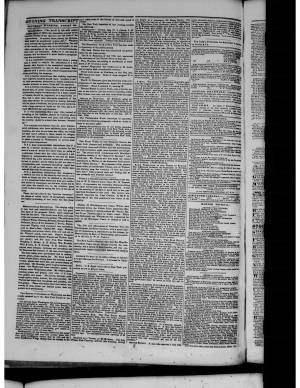
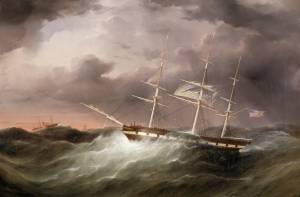
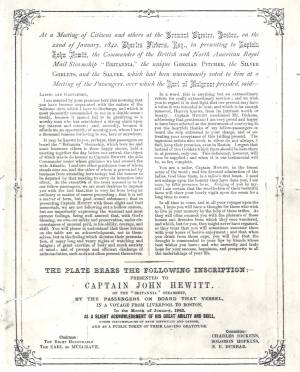
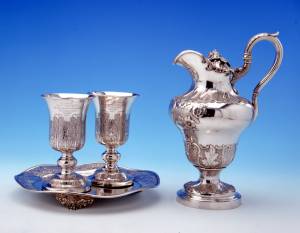
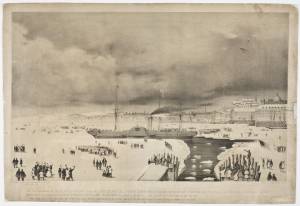

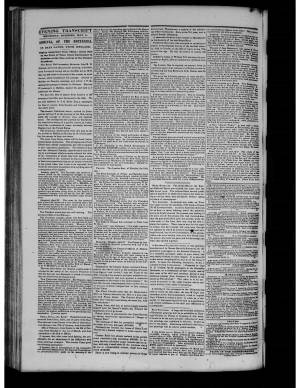

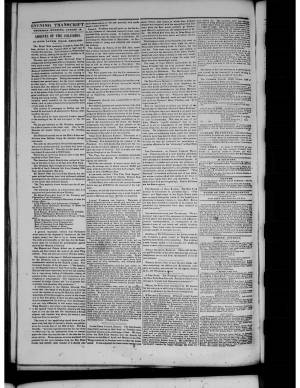
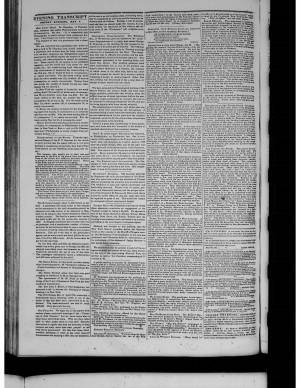
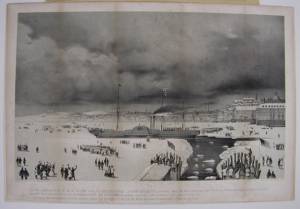
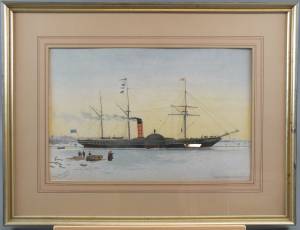
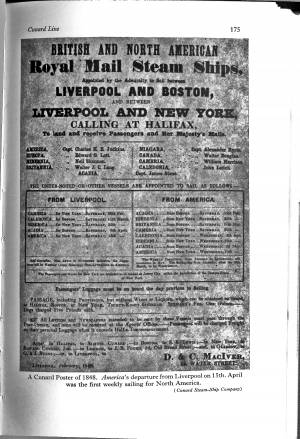
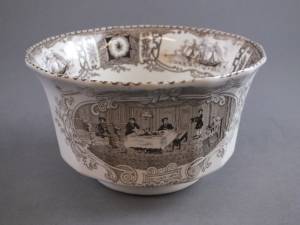

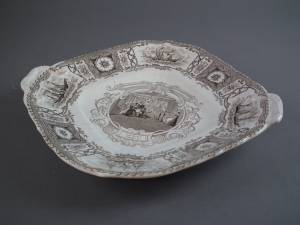
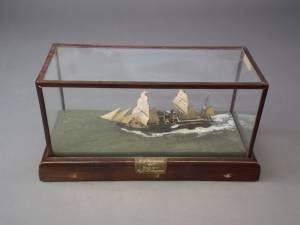
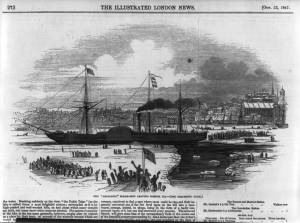
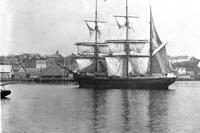

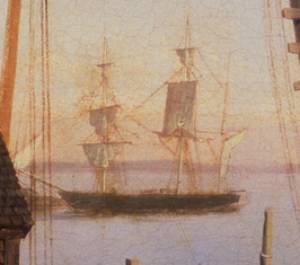


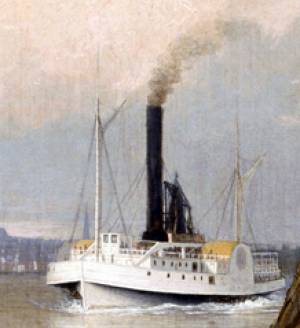

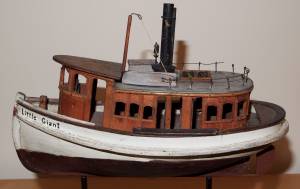
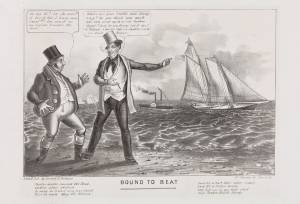

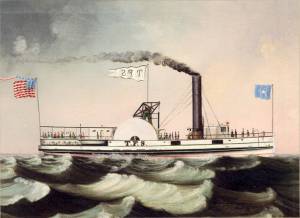
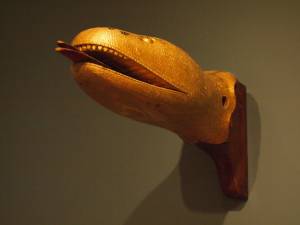
Commentary
The transatlantic passenger steamer "Britannia" was built by the Scottish shipbuilder Robert Napier for the Canadian entrepreneur Samuel Cunard. One of four sister ships (the other three, built in separate yards, were named "Acadia," "Caledonia," and "Columbia"), she entered service in 1840. Leaving Liverpool for Boston via Halifax, she arrived in Boston to a warm welcome after a two-week voyage. (1)
"Britannia" experienced her share of adverse weather and heavy seas. Her crossings to Boston in April 1841 and January 1842 were particularly stormy, which inspired Lane’s two very similar depictions of those voyages. Charles Dickens was in the 1842 storm and wrote about it eloquently, and it could be that famous 1842 crossing which is depicted in this painting.
One version of the painting was exhibited at Oakes Music Store in Boston in 1841. Lane also exhibited one at the 1842 Boston Art Association exhibition, and reportedly offered to sell a 1842 version to the Cunard Line. The firm refused, no doubt feeling that the hazards it depicted were too discouraging for potential passengers. (2)
In 1842, the Liverpool artist Samuel Walters portrayed the Boston packet "Nonantum" in a stormy Atlantic crossing to Liverpool with a westbound Cunard steamer riding a mountainous wave on the horizon. "Nonantum" returned to Boston in the summer of that year, presumably with her portrait onboard for delivery to its owner. Assuming Lane saw this painting, the background detail may well have been the inspiration for this, his second depiction of "Britannia." (3)
Lane may well have borrowed more from Walters’s painting. The fine brushwork in the wave crests has no precedent in his earlier known work. Likewise, the light and shadows in waves and clouds bear close resemblance to those seen in Walters’s more dramatic at-sea paintings. In both the Lane and Walters depictions, the light bursting through the clouds silhouettes the hulls and rigging, while reflected light in the foam contrasts dramatically with the dark hulls. The net results portray violent forces of nature stressing the laboring ships to their limits. Yet for all this violence, both artists employ the most delicate brushwork on the wavelets and ripples that lend realism to the water.
– Erik Ronnberg
References:
1. Paul Forsythe Johnson, Steam and the Sea (Salem, MA: Peabody Museum of Salem, 1983), 61–65.
2. Ibid., 63
3. Daniel Finamore, et al., Across the Western Ocean: American Ships by Liverpool Artists (Salem, MA: Peabody Essex Museum, 1995), 18; (essay by A.S. Davidson), 48.
[+] See More